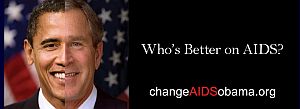A new advertising campaign puts forward an image of a president who appears to be half Barack Obama and half George W. Bush. The attention-catching photo introduces this question:
"Who's better on AIDS?" it asks.

Promoted on the Internet and on posters in Washington, the campaign is sponsored by the AIDS Healthcare Foundation, an advocacy group that also provides medical treatment and HIV testing in 26 countries. The organization is upset that Obama didn't appear at the International AIDS Conference held in Washington from July 22 to 27 -- the first time it took place in the U.S. in more than 20 years. Another reason? Obama has asked Congress to cut spending for fighting HIV and AIDS.
We thought this was an excellent opportunity to review Obama's one AIDS-related promise on the Obameter. As a candidate, he said he would provide at least $50 billion by 2013 for the global fight against HIV and AIDS. He also made a series of related pledges:
- at least double the number of HIV-positive people on treatment
- continue to provide treatments to one-third of all those HIV-positive people who desperately need them
- pay a fair share of The Global Fund to Fight AIDS, Tuberculosis and Malaria
- expand existing programs to help millions of children orphaned and made vulnerable by AIDS
- prevent violence against women and girls
- increase the number of health care workers by at least one million
We'll take these in order.
Most of the administration's spending on HIV and AIDS comes from a program called the President's Emergency Plan for AIDS Relief, or PEPFAR for short. There are different ways to count Obama's commitment here -- budget requests, the amount obligated, or actual spending. Suffice to say that the administration spent an average of $5.5 billion per year on direct HIV and AIDS programs between 2009 and 2011, and is on pace to spend about $5.1 in 2012. That accounts for slightly more than $21.6 billion in four years.
The administration also spent about $4.4 billion through annual donations to The Global Fund to Fight AIDS, Tuberculosis and Malaria. This is an international fund that gets money from governments and private donors, such as the Bill and Melinda Gates Foundation. The Global Fund pays for testing, antiretroviral drug treatment and basic care for children orphaned by HIV and AIDS.
That puts U.S. spending on HIV and AIDS abroad at about $26 billion, still short of the $50 billion figure mentioned in Obama's campaign promise.
The AIDS Healthcare Foundation complains the administration is cutting back on global HIV and AIDS money, and in one way this is true: Obama asked for about $4.5 billion for the 2013 PEPFAR budget, a 10.7 percent decrease from average level of spending in the last four years.
Less money doesn't mean fewer people treated, though. By lowering the costs of antiretroviral drugs and their distribution, the federal government has more than doubled the number of HIV-positive people receiving treatment -- fulfilling one part of Obama's promise -- even as spending has remained flat.
It's also worth noting that the U.S. has increased its annual contribution to The Global Fund to Fight AIDS, Tuberculosis and Malaria by about $300 million, with a request for another $350 million.
What about providing treatment to at least a third of those desperately in need? This is an area where the president far exceeded his goals. The United Nations Programme on HIV/AIDS -- usually abbreviated to UNAIDS -- says 54 percent of HIV-positive people in low- and middle-income countries, or about 8 million people, receive treatment today.
Another part of Obama's pledge: The U.S. should pay its "fair share" of financial contributions to The Global Fund to Fight AIDS, Tuberculosis and Malaria.
There isn't one definition of of a donor's "fair share," but a 2012 report by the Henry J. Kaiser Family Foundation and UNAIDS sheds some light on the issue. Depending on which measure you use, the U.S. was either first or sixth in the world in giving money equal to its wealth, relative to other countries in 2011. Either way, the U.S. is the biggest donor to The Global Fund, accounting for 32 percent of the fund's total contributions in 2011. That's a higher proportion of the total contributions than any year since 2007.
Obama's promise mentioned children who become orphaned because of HIV and AIDS. In 2009, the United Nations Children's Fund estimated that 15 million children worldwide had lost one or both parents to AIDS. About 10 percent of PEPFAR money goes to orphans and other children affected by HIV and AIDS. We couldn't find any sign of a major expansion, but children are already a "huge part" of the U.S. strategy for HIV and AIDS, said Christine Lubinski, vice president for global health at the Infectious Diseases Society of America and HIV Medicine Association.
Preventing sexual violence, such as rape and female circumcision, was part of the Obama campaign pledge because the government estimates "the risk of HIV among women who have experienced (sexual) violence may be up to three times higher than among those who have not." Under PEPFAR, the U.S. increased spending on programs that try to reduce sexual violence against women in 28 countries from $38 million to $57 million. The U.S. also launched a pilot program for preventing and understanding sexual violence in three countries -- Mozambique, Tanzania and the Democratic Republic of Congo -- which cost another $48 million.
Nobody we interviewed could provide us with an exact number on health care workers involved in HIV and AIDS across the world, or much that has increased under Obama. The White House does have a goal of expanding the number of health care workers by 140,000 by 2014.
So, who is better on AIDS, Bush or Obama? Lubinski said Obama has been far stronger on domestic programs, something we didn't rate here. On the global fight, Bush showed greater personal commitment to the cause, but Obama spent about as much money on HIV and AIDS programs, in spite of the recession he inherited.
"It's not really fair to hold the president accountable in a rigid way. The floor fell out with the economy," Lubinski said. "I think overall, it's been a plus."
Taken together, Obama isn't spending as much as he said he would on HIV and AIDS abroad, but he has delivered on many of the outcomes that matter. We rate this a Compromise.


